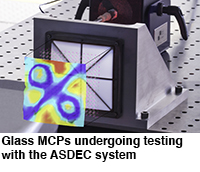ASDEC shows capabilities with small and lightweight system vibration testing
12/11/2015
Vibration measurement and analysis of extremely small and lightweight systems that would be impossible with traditional accelerometer-based techniques is handled well by the non-contact laser doppler vibrometers at the Advanced Structural Dynamics Evaluation Centre (ASDEC), as demonstrated in a recent piece of work with the Space Research Centre at the University of Leicester.
The task involved testing glass microchannel plates (MCPs) used as X-ray optics in space science instrumentation by the Space Research Centre. These are typically 40 mm × 40 mm × 1.2 mm glass plates with 20 micron square pores with an iridium coating to increase reflectivity. The front faces of the plates are covered with a thin layer of aluminium foil (60 nm) spanning the pores to reduce the thermal load and to block visible light.
Testing MCPs is critical in the development of satellite systems. Engineers need to understand the structural characteristics to ensure durability through launch and into the expected life of the system. However, even the slightest touch can ruin the device, damaging the structure or removing the film. It is also a requirement of all space hardware that the behaviour under structure-borne vibration and acoustic excitation must be characterised.
This testing can also be used during manufacture as a measure of part quality; for example, answering the question ‘is the MCP manufactured correctly?’ Detailed surface scans can reveal, for example, the uniformity of the bonding of the aluminium foil to the MCP grid.
Jon Sykes, Senior Mechanical Engineer at the Space Research Centre, said: “The facilities at ASDEC provided the perfect solution to conducting necessary vibration testing on parts that are so light and delicate any other testing method was impossible. ASDEC also brought a level of expertise that was very impressive and gave us great confidence throughout the testing procedure.”
Tim Stubbs, General Manager at ASDEC, said: “Our work on MCPs is just one example of the wide opportunities to evaluate structural dynamics in high-precision instruments, which previously had to go untested, potentially with critical cost and mission implications. By offering this capability of measurements on delicate precision instruments, ASDEC brings an understanding of structural dynamics to test objects that were previously out of the reach of traditional methods. Our scalable offering also allows the use of a portable system for situations where our customers need the test work to be done on their site, which is critical in many space applications.”
ASDEC is able to deploy its portable system in any test location, even clean room environments, to undertake detailed vibration measurements of systems and instruments such as MCPs. Scanning lasers allow for highly-detailed analysis of the entire surface of the plate, without the need for contact and the risk of damage.
www.asdec.co